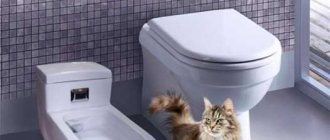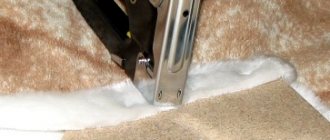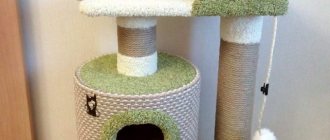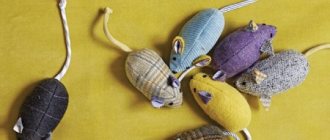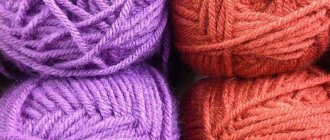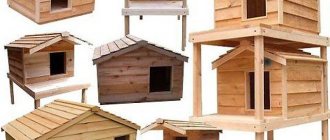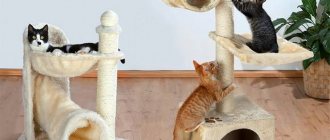A cat collar has different functions.
What does a person think about when he hears the word “collar”? Of course, about the dog. It is unlikely that, for example, the image of a Scottish fold cat, decorously walking around the apartment with a leather accessory around its neck, which also rings, appears in your head.
The article tells you what types of neck straps there are, which ones you can’t make yourself, and which ones you can. You will also learn how to accustom your cat to the accessory.
How to make a cat collar with your own hands
Most owners love their pets very much, and some, especially girls and women, also strive to somehow additionally decorate their kitten.
For example, a haircut, a bow on the tail or a decorative collar. Many cat owners are looking for beautiful collars for them in pet stores, and needlewomen prefer to make some kind of cat decoration with their own hands. In general, a cat does not need a collar, the exception being a flea collar for animals that go outside. However, it is so nice to see your pet in a new outfit.
Should I have an onychectomy?
Finally, we should remind you of the operation permitted in some countries to remove the claws of the Domanikomanina Yes, this procedure will save the owners from a lot of trouble and will preserve the furniture, but is it really that harmless? After all, along with the claws, the front phalanges of the fingers are removed, which affects the work of the entire support system.
A cat is a fairly mobile animal and without claws it is doomed to endless injuries - clinging is impossible. She will not be able to climb onto a low surface; it will be difficult for her to maintain balance. After the operation, you may suffer from pain for the rest of your life, which is due to a violation of the habitual state of the body.
DIY cat collar
Despite all of the above, there are plenty of people who like to dress up a furry family member, as well as ideas for creating a decorative cat collar.
The most important rule when creating a collar is that it should under no circumstances interfere with or choke your pet.
Otherwise, seeing the owner with decoration in her hands, the animal will urgently hide in hard-to-reach places.
You can create a collar from anything - from scraps of leather, sewn from thick fabric, beads or beads, from chains, woven from elastic bands, knitted or crocheted - there are a lot of options.
What should a scratching post be like?
The main requirement for a place to sharpen cat claws is strength. — The surface of the claw blade should be fibrous and rough. The fibers must break, otherwise the pet will hang on the sharpener, becoming entangled in it.
And lastly, the material must remove static electricity: furry pets with their furstekikikikikikik
If you combine all these requirements, you will understand that they are fully met by natural materials: wood, hemp, burlap, coarse woolen fabric, thick cardboard.
Important! Devices for sharpening claws should not contain metal nails, screws or claws omnepemmetemob, inmateb
You can get by with a simple board, but if you really care about your cat, it is better to equip the structure with a bed on a hill.
The furry owner will be able to survey her possessions, the highest support as razodimtikamotikamotikamotikamotikam
Important. Cats never leave marks where their den is, this is an instinct of self-preservation.
If your pet is large enough, then the sharpener should match its size. When creating a product, you first need to focus on the dimensions of the cat. Especially when you are making a wall model, otherwise the animal may scratch the wall.
The length of the scratching post should be 5-10 centimeters of the length of the animal itself (the tail, in this case, is very long). The width of the product is oriented towards the width of the outstretched paws.
Beautiful collars for cats: interesting ideas, master class
Great skill is not required to create a collar, so even a beginner can do it. However, it is worth considering that the collar is being made for a cat or a kitten. Depending on the size of the pet, you can make a thick or thin collar. If your pet is walking outside and the collar is supposed to reduce the chances of catching a cold, then a thicker version will do; a thin collar will not be as effective.
So, to create a collar you will need to choose a material (something natural is best, synthetic materials can cause allergies in the animal and wearing the collar will not be safe).
If the collar is made of beads, beads, chains or something like that, you will need to put fabric under it, otherwise it will cling to the pet’s fur. An everyday collar should be easy to put on and use. A ceremonial collar, which the animal will wear occasionally, can be made more sophisticated.
The length of the collar is calculated as follows: it is necessary to measure the circumference of the animal’s neck and take into account that a finger must fit freely between the collar and the neck.
Collar made of leather or fabric
Materials:
- A piece of leather (or thick fabric)
- Rivets (can be used as decoration if desired, can be placed in the studio)
- Fastener (buckle, hook, button and more)
- Decoration (rhinestones, bows, bells and more)
Making a collar from ready-made materials is very simple: a strip of the required length is cut out of leather or fabric, the edges are processed if necessary, decor is glued or sewn onto the strip, and a clasp is attached. The collar is ready and can be used.
Collar made of rubber bands
Weaving from rubber bands is a new technique that is quickly gaining popularity.
The simplest collar can be woven even on your fingers! One elastic band twisted in a figure eight is put on two fingers, and then two elastic bands in the usual way, then the loops of the lower elastic band are removed and thrown forward, then another untwisted elastic band is put on, and the lower one is removed and reset, and so on to the desired length.
How to crochet
Any pattern will be suitable as a basis, for example, cast on 90 air loops, and in the second loop, knit a chain with double crochets in the opposite direction. At the end, a lifting air loop is made and everything is knitted back with a single crochet. At the end - again an air lifting loop and another row of double crochets. All that remains is to decorate the finished collar.
For fleas
It is not recommended to make flea collars yourself, as they work thanks to insecticidal and acaricidal impregnation. And if you spray this impregnation on a regular collar at home, there is a risk of poisoning your pet. It is better to buy a special collar at a pet store so as not to inadvertently harm your pet.
Mistakes when making a cat scratching post
The most common mistakes when making a scratching post yourself are related to the wrong choice of step-by-step instructions:
- To create a vertical scratching post, use a rope that is too thin and weak - the cat will quickly tear it apart.
- Horizontal rugs are covered with poor quality fabric.
- Instability of the posts - if the structure falls and frightens the cat, it will no longer approach the cat.
- Exposed elements of metal fasteners, screw heads or other similar parts can be rubbed off.
- The use of synthetic fabrics and adhesives can cause poisoning.
Why does a cat need a collar, leash or harness?
Even the most phlegmatic domestic cats are happy with the new experiences that a walk gives. And if your pet has an active temperament or has lived on the street in the past, he may feel sad, sitting in the apartment all day long. In order to make walking with your cat safe and comfortable, special devices come to the rescue: a collar, a leash and a harness.
Walks give cats many new experiences
Collar
Some owners purchase anti-parasitic collars for their cats, which the pets even wear around the house. But for a walk you need a more reliable collar with a strong clasp.
If your cat walks, as the saying goes, on its own, you need to choose a comfortable collar for it that will not allow the animal to get caught on protruding dangerous objects and will not fly off during active movements. In addition, the collar must have a mount for an address book on which you can write the cat’s name, your phone number or address. If the pet gets lost or gets into trouble, the people who find it will be able to return the poor thing home. When deciding to walk an animal on its own, you need to be aware that it is unsafe.
The pet's collar must have a tag with the owner's number on it.
An option in which you can not worry about your pet, but at the same time give him the joy of a walk, is to use a collar in tandem with a leash.
Leash
As mentioned above, a leash is the key to a safe walk with a cat. It is best to opt for a long but strong leash. A chain, unlike dogs, is not suitable for cats - it is heavy and can scare your furry or cause him pain.
The cat's leash should be soft and light
And, of course, even when walking on a leash, put a tag with contacts on your cat’s collar - just in case.
Harness
What should you do if your mustachioed pet refuses to walk on a leash and doesn’t like the collar? It doesn’t matter, you can replace these devices with a harness. It looks like an interweaving of wide straps that cover the chest, part of the back and paws.
As a rule, this object irritates cats less and causes less pain when moving, because the throat is a sensitive part of the body of any living creature. When wearing a harness, most of the load falls on the chest, not the neck. And in case of danger (an approaching dog, falling into a hole), it is much easier to grab the pet by the back strap of the harness than to pull the leash.
Most cats enjoy being walked on a harness rather than on a leash.
My cats (both those who came into the house as babies and former street residents with experience) love walks in the fresh air. However, they absolutely do not like harnesses. Animals fall on their stomachs or sides, refuse to move and even lose interest in walking. The situation is completely different when pets are wearing a collar and an ordinary leash. Cats behave appropriately, move along the ground, sniff the grass, albeit with some caution. Perhaps it's because my cats live with dogs and see them walking on leashes. I don’t see any other reason for preferring this accessory to a harness. If it were not for the silent but expressive protest of the cats, I would prefer to walk them on a harness.
What is a scratching post for?
The simplest reason is that pets have long had to get their own food.
No less interesting is the hypothesis about the relationship between cat health and the claw scratching procedure. There is an opinion that here we are talking about a kind of exercise for the whole body. The surface on which the cat rests acts as a training device. All muscles and bones of the skeleton take part in the process.
The next reason also concerns health. Towards the end of the paws, pads and claws there are many nerve endings and blood vessels.
By scratching, the cat massages sensitive areas, improves its tone and even gets nased. Often, a cat, stretching on a scratching post, purrs contentedly, how such training delivers.
It is believed that with the help of a nail polisher, animals renew their claws and thus prevent the possible development of inflammatory processes in the paw pads.
How to make your pet's ammunition with your own hands
Don't worry that pet walks will put a strain on your budget due to the purchase of equipment. All these things can be done with your own hands from scrap materials. Handmade leashes and collars have a number of undeniable advantages compared to purchased ones.
- Saving money.
- No need to drive or go to the pet store.
- The owner can show creativity when sewing products.
- Your pet's ammunition will be unique.
- Equipment tailored to your pet’s individual parameters will fit better than store-bought ones.
The disadvantages include the following:
- You need to spend time. If you are not used to making things with your own hands, you may need a lot of it.
- You are responsible for the reliability of the ammunition. If you don't make good enough fastenings, you risk losing your pet.
Making a collar for a cat
So, you can’t do without a collar with an address tag on a walk, so it’s better to start making ammunition with it. To do this, you can use leather, fabric (nylon, velvet, velor) or improvised materials. The clasp for the collar can be made of metal or plastic; you can also sew Velcro or ties instead (which is less reliable). To work you will need:
- scissors;
- thread and needle;
- a thimble and an awl (especially if you are sewing leather or thick fabric);
- sewing machine - if available;
- measuring tape or string with handle:
- fabric (leatherette, jeans, other available materials) or nylon sling - your choice;
- accessories for decorating the collar (beads, rhinestones - optional);
- purchased fastex fastener, metal buckle or Velcro;
- half ring for attaching a leash or address card.
First you need to determine the length of the future collar. To do this, measure the circumference of the animal's neck, and then add a distance the size of two fingers (about 5 cm) to this measurement. This is done so that the collar does not put pressure on the cat's neck. Next, add another 5–7 cm to adjust the fastener.
The comfortable width of a cat collar, in turn, is usually about 2–2.5 cm.
Based on these parameters, a strip of fabric is cut out or a suitable nylon sling is selected.
Nylon sling is the simplest material for making a collar.
The end of the tape is passed through one of the two parts of the fastener, folded over and secured with a seam. The ring for attaching the carabiner is also sewn on at this stage, immediately after the clasp.
This is what the collar looks like after part of the fastener and the half ring are sewn to the sling
The other, remaining free end of the sling is threaded through the double-slot buckle and the second half of the fastener, which is not yet sewn. The sling is then pulled through the buckle again, forming a loop. The “tail” of the sling, threaded through the buckle, is bent back 3 cm and secured with a seam.
In order for the fastenings to be reliable, it is better to lay a double seam
If making a collar with a fastex clasp seems difficult, you can simply sew a buckle and ring to one end of the product, and make holes for the clasp at the other end of the collar with an awl. Whatever option you choose, there is always room for imagination - the collar can be decorated with decorative elements to your taste.
Video: options for making a collar yourself
Making a leash
A leash for a cat is made according to the same principle as a collar.
You need to find it at home or buy a sling and carabiner. The length of the future leash depends on your height and on how far you allow your pet to move away (usually 1.5 - 2 meters).
One edge of the sling is threaded into a carabiner, pulled inward by 2–4 cm, folded over and sewn on. For maximum reliability, you should first make a seam along the edge of the curved sling and a seam near the carabiner. Between the two parallel seams formed, two more seams are sewn - crosswise.
How long will a scratching post last?
Any, even the most expensive branded scratching post, wears out over time and loses its original appearance. The frequency of replacement of the scratching post depends primarily on:
- Product quality.
- Conditions of its operation.
- Caring for her.
So which one should you choose? Advice from cat owners will come to the rescue. The rating is based on customer reviews:
- Sisal scratching post. Can last up to 3 years. This is a conditional figure. The thicker the sisal rope, the longer it will last.
- Jute model - up to 2 years. Also depends on the thickness of the rope.
- Carpet - about 1.5 years.
- Faux fur, which can often be found in cat complexes - up to a year. And this is subject to regular cleaning.
- There are two types of cardboard. Whole cellulose, higher quality, lasts up to six months, double-sided cellulose - up to 12 months. Waste cardboard, the cheapest, is thrown away 2 months after purchase.
The sisal scratching post lasts the longest!
Cardboard house
The main advantage of a cardboard house is the variety of models. Cardboard houses are assembled in the form of a birdhouse, castle, tent, cave. And that is not all…
It is possible to assemble a cardboard house yourself. On the Internet you can find sample templates that will help you get the job done right. But do not forget that a house made of such material is not durable. Having played out, the pet can easily destroy its building. Owners should not be upset. You can always make a new “fortress”.
Useful tips
- Cats are more timid, more active and flexible than dogs. If you plan to walk your pet on a leash, buy or sew a harness. It secures the animal’s body well and leaves little chance for escape. You will also have to gradually accustom your pet to a harness.
- Do not delay in training your kitten to use a collar or harness. The older the animal, the more difficult it is to accustom it to foreign objects on its body.
If the cat comes into the family as an adult, you will have to be patient. Perhaps he will agree to wear only an anti-parasitic collar. The harness and leash will remain gathering dust in the closet.
- A cat over 10 years old will prefer a long nap to a walk on a leash.
- Objects on the animal's body can cause allergies. At the first signs, immediately remove the accessory and consult a doctor.
Cats are independent creatures. No matter how much the owner would like to take a morning or evening promenade with his beloved pet on a leash, perhaps this will remain a dream. Or the animal will turn out to be a minimalist - no collars or harnesses. Only impeccably licked wool.
Base options
Item needed:
- strong enough to support the weight of the animal;
- lightweight so that bulky structures are not required for mounting to the wall;
- Receptive to glue well, good for processing with tools.
Cheapness is an important parameter, but not as much as for coating. The base is expected to last a long time. Is this always necessary? Assess the complexity and wear time of the craft. It may turn out that it is more rational to replace it completely than to remove the glue.
For the base take:
Note!
How to make wooden shelves with your own hands - original design options
Kinusaiga technique for beginners: what is it, a description of creating paintings from threads
How to weave a figurine from rubber bands: how to learn to weave animals, toys and what you can make from rubber bands on a slingshot
- plastic water and sewer pipes - they are easily sawed across and lengthwise, it is easy to make a frame of any shape from them with reliable fastenings from standard adapters;
- pieces of plywood of various thicknesses;
- sections of tree branches after sanitary pruning at the dacha (necessarily healthy fragments, so as not to bring pests into the house).
The branches can also be used for decoration: a cat lying on them, attached to the ceiling, will decorate any apartment.
LiveInternetLiveInternet
—Tags
—Quote book
Knittstyler: What is it and how to work with it. Here is a program that can significantly...
Knitted bag Bag with leaves. Very beautiful, I want to grab the hook and start knitting.
Knitting dolls, master class
FLUFFY KEFIR CAKES: TASTY AND FAST FLUFFY KEFIR CAKES: TASTY AND FAST.
—Categories
- BRUGGE LACE. (142)
- MACHINE KNITTING (16)
- FOR THE ARTIST (2)
- EMBROIDERY (1)
- PAPER CRAFTS (1)
- COMPUTER PROGRAMS (0)
- CANDY STAND. (15)
- ALL ALL “KNITTING” TRICKS. (164)
- ALL UTILITIES. COMPUTER. (215)
- BEADWORK. (9)
- KNITTING FOR INTERIOR: (504)
- curtains (30)
- rugs (40)
- blankets, bedspreads and pillows (211)
- potholders (22)
- napkins (80)
- tablecloths (126)
- flowers (9)
- KNITTING FOR CHILDREN. (490)
- accessories (17)
- bolero (4)
- hats (155)
- for boys (4)
- suits (11)
- sweaters, sleeveless vests, jackets (17)
- measurements (3)
- coats and jackets (6)
- booties (73)
- dresses and sundresses (80)
- rugs, blankets (19)
- panties (2)
- skirts (15)
- KNITTING FOR PETS, (5)
- KNITTING FOR MEN. (23)
- KNITTING FOR LEGS (shoes, socks, etc.) (70)
- CROCHET: (3195)
- bolero (82)
- collars (17)
- jackets and sweaters (241)
- vests and sleeveless vests (95)
- cardigans (54)
- suits (98)
- swimwear, lingerie (155)
- coat and poncho (57)
- dresses and sundresses (623)
- pullovers and jumpers (178)
- tops and tanks (346)
- tunics (270)
- patterns and motifs (670)
- flowers (135)
- shorts, trousers (31)
- skirts (255)
- KNITTING ON A FORK. (60)
- KNITTING WITH FUR, BEADS. (82)
- KNITTING: (555)
- blouses (3)
- bolero (9)
- jackets, cardigans and sweaters (132)
- vests and sleeveless vests (44)
- suits (7)
- coats and ponchos (44)
- dresses and sundresses (41)
- pullovers and jumpers (95)
- tops and tanks (27)
- tunics (36)
- knitting patterns (106)
- skirts (30)
- KNITTING ACCESSORIES: (805)
- costume jewelry (44)
- hats (173)
- umbrellas (43)
- bibs (3)
- gloves, mittens and belts (41)
- bags (177)
- shawls, scarves, stoles (327)
- KNITTING MODELS WITHOUT PATTERNS (6)
- MAGAZINES ON KNITTING AND HANDCRAFTS. (84)
- HOME IDEAS (38)
- ISOTERICS, NUMEROLOGY (46)
- INTERESTING IDEAS (handicrafts). (57)
- IRISH LACE. (672)
- KANZASHI (51)
- ROOM FLOWERS. (23)
- DOLLS AND TOYS. (116)
- COOKING: (889)
- vegetable dishes (65)
- in pots (13)
- in sleeve (2)
- baked goods (201)
- desserts and drinks (86)
- winter preparations (75)
- snacks (165)
- meat and fish dishes (192)
- recipes to note (119)
- salads (96)
- tips, ways, tricks (56)
- RIBBON LACE. (106)
- LITERATURE: (75)
- aphorisms (24)
- parables (10)
- poems (41)
- FAVORITE MELODIES. (20)
- MACRAME (4)
- MASTER - CLASSES. (71)
- MY WORKS: (97)
- knitted items (38)
- souvenirs and crafts (59)
- MY MASTER - CLASSES. (3)
- MY RECIPES. (1)
- MY LIFE, EVENTS, REFLECTIONS. (3)
- CONTINUOUS KNITTING (71)
- MARK FOR YOURSELF: (968)
- sundry (65)
- health, body care (373)
- prayers and spells (335)
- online sales (6)
- psychology (56)
- work (9)
- entertainment (5)
- runes (10)
- self-knowledge (28)
- simoron (83)
- palmistry (6)
- WEAVING (newspapers, beads, etc.). (34)
- JOKES. (21)
- SALT DOUGH (4)
- SCHEMES (12)
- TENERIFE (LUMA). (17)
- TUNISIAN KNITTING (1)
- LOINT KNITTING. (275)
- FREEFORM. (46)
- SEWING: (324)
- art textiles (7)
- cut (3)
- patterns (123)
- combination of fabric, leather and knitting (156)
- fabric flowers (1)
- curtains (11)
- LACE LACE (135)
- THIS IS INTERESTING. (26)
Corrugated cardboard house
The idea of creating such a house came to the minds of the inventive Japanese. There are no difficulties in making a home for a pet and it will please cats of any temperament. The house looks like a beehive due to the combination of raised cardboard lines. The craft can be given different shapes. The most popular are spherical shapes. The ribbed structure of this type of cardboard will allow the cat to sharpen its claws at the right time.
You will need:
- Cardboard;
- PVA glue;
- soft bedding.
Manufacturing instructions:
You need to cut circles out of corrugated cardboard. The size of the circles must follow the bending lines of the future house. Then the elements are glued together with ordinary office glue. For the comfort of your pet, it is advisable to lay a pillow inside the ball.
Plywood house
It is possible to build a house from plywood. You need to prepare the necessary material and carefully carry out all stages of the work, following the step-by-step instructions for creating a house yourself.
You will need:
- Fastening tool;
- carpet;
- beam;
- rope;
- sandpaper.
Construction method:
The house model consists of a lift and a miniature booth. Elements of the house are cut out of a piece of plywood - the roof, a small ramp and walls. Be sure to sand the edges of plywood elements. Then, using staples, the parts of the house are covered with fabric and fastened.
The base mounted to the booth must be slightly wider than the main structure for making the ladder. The legs are attached to the base. A shelf is attached from above to a beam wrapped with rope using a tool.
You can look at pets endlessly. We must love them and create comfortable living conditions.,

